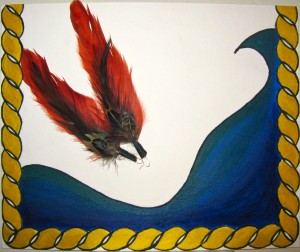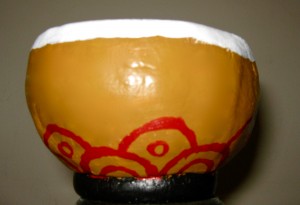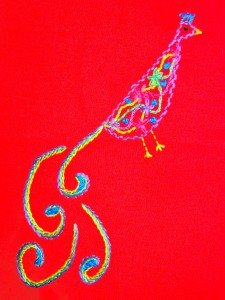On Islam:
Having grown up with Catholicism as the name brand religion of my culture, I had grown comfortable with the idea of religion as a form of oppression. The centrality of self-denial and mea culpas to this form of religion made me realize at a young age that I was well suited to atheism. My disdain for religion was reinforced by the hatred and intolerance that I associate with the very vocal anti-gay, anti-contraception, Creationist groups in the United States, as well as historical events like the Crusades, or the rise of the Ku Klux Klan. I had, in my infinite teenage wisdom, divided Christians into two categories: fundamentalist, and delusional. That was that. I saw what I had told myself was the truth about religion, and no amount of “Jesus loves you” could bring me back.
Then I met Islam. No, this is not a story of conversion in the usual sense. I am not a Muslim, nor do I purport to be in search of God. I met Islam, like many Americans, in the upheaval that was September 11, 2001. Like any good fifth grader, I remembered that Islam was a one of the “Big Three” monotheistic religions and that the central beliefs were called the Five Pillars. Beyond that, I imagined it was Christianity for the Middle East. If not for the reaction 9/11 provoked, I doubt I would have ever developed a sincere interest in religion. The huge backlash against Islam, that we are unfortunately still experiencing today, provoked such disgust for America in me that I felt I had no choice but to prove to myself that Islam was beautiful. Typical rooting-for-the-underdog syndrome, I know.
I understood hatred to be a symptom of misunderstanding and miscommunication, and so set out to engage with Muslims and Islam. What I found was love, not hate. Unlike with Christianity, I was removed enough from Islam to appreciate its message, without the years of personal experience tainting every concept. Backwards as it may seem, Islam has helped me grow more tolerant of Christianity, and religion in general. I can now see beyond the idea of religion as the “opiate of the masses,” and have opened myself up to the understanding of some of my personal beliefs and actions as being spiritual in nature.
The seven pieces that I have produced over the course of the semester have been my attempt at continuing this exploration of Islam on a personal level. Each one of these pieces is a distinct part of the process of internalizing an understanding of Islam. Though in some ways specific to the material being addressed, the ideas underlying these responses represent a complete survey of my developing perception of Islam and spirituality.
God is love. If there is anything I am taking from this class it is this idea. Somehow, I had managed to gloss over this in my previous attempts to understand Islam. I knew that love of God was the driving force behind many of the miracles of poetry and art produced by Muslims, and that God’s love is something man at once has and must seek. Yet, the idea that I could most readily connect with was the one I had ignored. God is love. With this simple statement it becomes easier to understand the why behind not only religion, but human behavior as well. We’re not crazy; we’re in love. Somehow that makes it better. Or more beautiful, at least.
On Art:
I had never thought to merge the idea I have of art with the monolithic concept that is Harvard for me. Much like Professor Asani’s concept of Islam vs. islam, art and Harvard do not seem compatible, yet I know that art is the lubricant that eases the paths of harvard life. Whether or not their work is put on exhibit, students are creating something personal, something to give their lives meaning. We are all working together, even in an environment as individualistic as Harvard.
This new understanding of art as a shared domain has been a long time coming. For as long as I can remember, I have had trouble sharing any physical manifestation of my inner self. I get great satisfaction from working with my hands, but have shied away from sharing the end product with anyone but my closest friends. I am sure that any psychiatrist would trace this need for privacy to a fear of rejection, and perhaps that is true. I however, have continued to justify this by telling myself that my art is of such rough construction that it can only have meaning to me.
Given this, my decision to take this class seemed somewhat unnatural, despite my love for the subject. Faced with this challenge, I figured that I would either get inspired or would have to fake it. Thankfully, the structure of the responses was such that I was able to latch onto the images and ideas that resonated with me, and disregard the rest. Yet despite this flexibility, I continued to find myself making these responses and waiting to post them online until there was absolutely no alternative. I could not let go.
It was not until we were asked to contribute to an art exhibit on campus that I could bring myself to let go of my work (under the guise of helping another project of course). The experience of displaying my work, even to the very limited audience of my classmates, has made me appreciate the release that this provides. If making art is cathartic, the invasiveness of putting it on display is even more so. Although I acknowledge that I will continue to struggle with this part of the process, I have realized that not sharing something produced with sincerity is a disservice both to the artist and to anyone who may benefit from viewing it.
With that, I leave you my portfolio. My motivations for creating each is described, but ultimately the analysis is up to you.
May 4th, 2012

For this project I decided to paint a mihrab symbolizing the Eight Doors of Jannah. As the mihrab indicates the direction of prayer (qibla), it seemed appropriate to use this image as a guide towards Jannah. Inscribed upon these doors are the Asma al-Husna, as remembrance (dhikr) of Allah is central to Islam, and thus to the passage through these gates. The ayat [59:22] along the bottom of the painting reinforces this, as well as emphasizes Allah’s omniscience.
Rather than ascribing each of these gates ritualistic meaning, as is done in various accounts of hadith, I have chosen to interpret these gates as qualities on the way to one’s reunion with Allah.
- The adornment forming the outermost gate is intended to convey the beauty emanating from Jannah, and the desire for all of nature to press itself to the divine. This first gate I consider to be that of testimony/shahada, since recognition of Allah is one of the most basic principles of Islam.
- Beyond this gate is that of humility/submission, again one of the primary tenets of the religion. This is one of the doors containing the Asma al-Husna, as a reminder of the awe one should feel in the presence of Allah.
- The third gate is green, but otherwise unadorned. This door represents peace, playing off of the dual association of Islam with salaam and with the color itself (green often being used to describe Jannah).
- The subsequent blue gate symbolizes truth, and is again inscribed with the Asma al-Husna, as Allah is the One Truth [22:60].
- Next are the doors of justice (green), love (blue), and faith (black). These last three doors are built upon a foundation of purity (white), which for these purposes is also considered a gate. I have depicted the final door (faith) as black rimmed in gold to represent wholehearted trust in Allah, with the edges revealing only the slightest glimmer of what lies beyond.
April 29th, 2012

In thinking about my final response for this class, I decided that I wanted to create something that embodied the diversity of Islam, while at the same time conveying some of its shared ideals. I wanted to emphasize the idea of Islam as a unifying faith, but one which is subject to different interpretations on an individual basis. I chose to focus on capturing light, as this is a medium that is at once a symbol of knowledge, faith, love, and purity. Light’s malleable and elusive nature makes it particularly appropriate, as an understanding of God is anything but straightforward. This piece uses a variety of textures and surfaces to illustrate the many ways in which this light can be reflected and absorbed.
In addition to the different shapes and textures, I tried to hint at a depth of meaning by making this piece difficult to capture from a single angle. The topography of the aluminum, the shifting pattern of the glass marbles, and the contrast between the brilliant corner of white and the iridescent gold base are meant to mimic how the practice of Islam defies characterization.

The light of Islam is universal, but is reinvented by every surface that it illuminates.

April 29th, 2012

This piece is in response to our readings on the spiritual act of listening.
Of all my creative responses, this is the most personally meaningful to me. Having lived my entire life alongside the ocean, I have come to see its nearness as central to my existence. For me, there is nothing in the world that stimulates such a visceral emotional response as the sight, sound, and smell of the ocean.
I realize how much of a hippie/pagan this makes me sound like, but I really cannot deny the ocean’s importance in my life.
There are very few things that I felt the need to bring to Harvard with me from home, but seashells were at the top of the list. Shells, in addition to “containing the ocean”, contain memories. The simple act of holding one to my ear brings me tranquility, and gives me hope. More so than photographs, the shells I have brought with me are an anchor for my life.
Given this background, suffice it to say that I can agree with the idea of shells as a medium for transmitting the divine Word.

I decided to show this visually by painting the interior of this shell a bright gold.
April 29th, 2012

If you are profligate, if you are pure/You are but water mixed with dust, no more/A drop of trembling instability/And can a drop resist the surging sea? (2318-19)
This piece was inspired by our reading of The Conference of the Birds, by Farid ud-Din Attar. Rather than depict the birds themselves, I chose to focus on the hoopoe’s description of the effect that a single feather from the Simorgh had on the world.
In this painting, the feather’s descent is shown as a disturbance of the ocean beneath it. The ocean is at once receptive and violent, as the feather’s coming upends its previous state of tranquil ignorance. This disturbance incites a fervor that ripples around the world, and is the catalyst that allows the birds to reach their full potential. The splendor of the feather alone is not enough to guarantee a successful journey, but it is the spark that they were unknowingly awaiting.
This brings me to a seeming discrepancy in my work: the Simorgh let a single feather float down to the world, yet this painting shows the descent of two. The second feather, indistinguishable from the first, is the mirror which lies hidden in the breast of each of the birds. The birds union with the Simorgh is dependent on their discovery of this “secret counterpart” within themselves, yet this feather would never have been brought to light if not for the outward manifestation of the Simorgh’s existence.
I was really taken with the beauty and depth of this poem, and know it to be one that I will return to long after this class is over.
April 29th, 2012

I created this piece in response to The Beggars’ Strike, by Aminata Sow Fall. I sculpted a clay version of the calabash bowl carried by Senegalese beggars, and in decorating it, tried to convey the role that almsgiving plays in this society. In the novella, Sow Fall describes begging as an occupation no different from any other trade: in exchange for alms, the poor give their blessings, and help ease the consciences of donors.
Although a downtrodden population, the service they provide is depicted as integral to the functioning of society. Without the beggars to “drive away their bad dreams… and to maintain their hopes” (22) people are unable to unburden themselves of their troubles and fears. In this way, almsgiving is no longer an act of charity, but rather a safeguard against these worries.
The white interior of the bowl represents the purifying quality of almsgiving, and the hope that it imparts. The base of the bowl, in contrast, is black, as this is the part of the bowl closest to the beggar who is receiving this burden.

“O Prophet! Take alms of their wealth, wherewith you may purify them and may make them grow, and pray for them. Indeed, your prayers are reassurance for them.” (Qur’an 9:103)
March 26th, 2012

The idea underlying this piece is the use of bridal metaphors to depict the sacred union with the Divine. I was very struck by the power of the imagery in the gināns we have read, and feel that the degree of devotion expressed within these (and similar) poems perfectly encapsulates my personal image of what Islam means. The idea of “longing in separation” is one of the most beautiful concepts that I have encountered in religion thus far, and I wanted to create a design that brought together the humility and selfless veneration characteristic of these poems.
I chose henna as my medium because of its direct association with marriage preparations, and decided to decorate my feet rather than my hands because of their unassuming nature. More than this though, my decision was inspired by a poem of Rumi’s:
“I want to be where your bare foot walks,
because maybe before you step, you’ll look at the ground.
I want that blessing.”
I find it difficult to articulate the effect that these three lines have on me. To me, they are perfection. I cannot begin to imagine a love more pure and profound than that described here. Although my amateur henna abilities could never hope to convey this sort of sentiment, I tried to use my design to draw attention to the interface between the foot and the ground so as to emphasize this most humble form of contact. With this pattern I hoped to give an impression of the simple beauty and intimacy sought after in these poems.

March 22nd, 2012

I chose to create a piece that brought together the traditional geometry of Islamic art, and the figural representation of a mythical character. The peacock is associated with Paradise, yet has both negative and positive aspects to its story. Created from the nur Muhammad and placed at the gates of Paradise, the peacock is believed to be the most pious of birds. However, it is also associated with Iblis and the expulsion of Adam and Eve from Eden. According to myth, the peacock was approached by Iblis as he attempted to enter the garden, but denied him entrance. When Iblis finally made his way in and tempted Eve, Allah expelled them all, with the peacock being held as an accomplice. It is said that in punishment the snake lost her legs, and the peacock lost his beautiful voice.
Although not directly inspired by any of the readings for this course (the idea did come from lecture), I have always been interested in myths of origin, and found it interesting to see how this particular one was tied into a monotheistic religion. In researching the symbolism of the peacock in Islam I came across A Song of Muhammad by M.R. Bawa Muhaiyaddeen, in which he describes how Allah shaped nur Muhammad in the form of the peacock. Faced with the grace of Allah, the peacock began to sweat, with each bead becoming a different part of the world. In embroidering this, I tried to make the peacock as simple as possible, while still hinting at the bird’s potential: The five colors of its figure represent the five elements, as described by Muhaiyaddeen (water, fire, air, earth, and gold), with the tail shaped to reinforce this idea.

March 12th, 2012












